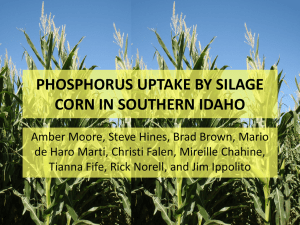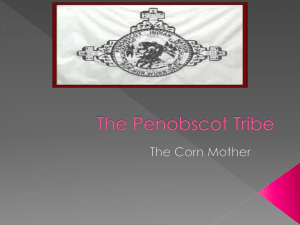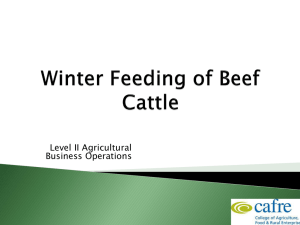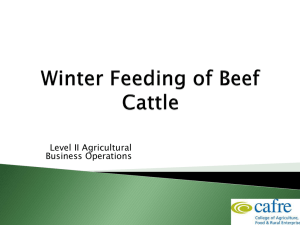PowerPoint
advertisement
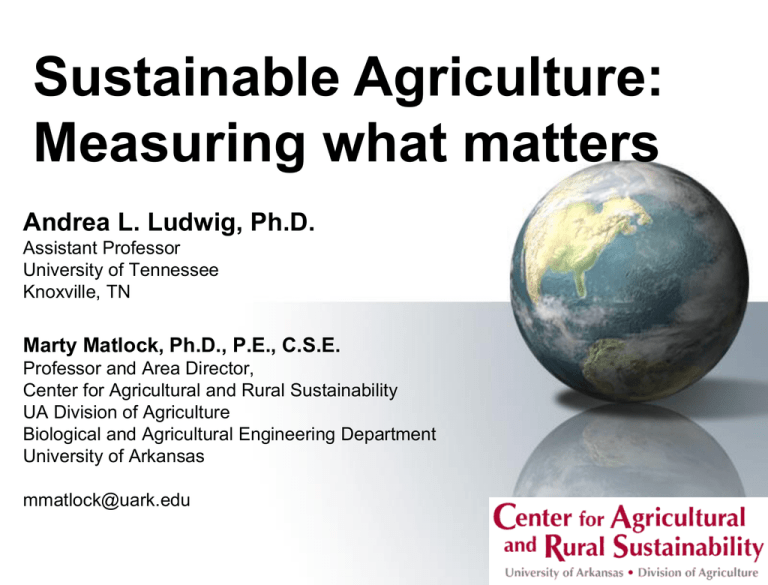
Sustainable Agriculture: Measuring what matters Andrea L. Ludwig, Ph.D. Assistant Professor University of Tennessee Knoxville, TN Marty Matlock, Ph.D., P.E., C.S.E. Professor and Area Director, Center for Agricultural and Rural Sustainability UA Division of Agriculture Biological and Agricultural Engineering Department University of Arkansas mmatlock@uark.edu Everything is Connected 2 Everything is changing 3 Sustainability 2050: The Challenge UN Population Projections Population (Billions) 12 10 8 6 4 2 0 1950 1960 1970 1980 1990 2000 Year 2010 2020 2030 2040 2050 4 Sustainability 2050: The Challenge UN Population Projections 12 Population (Billions) Projected with current fertility rates 10 8 6 4 2 0 1950 1960 1970 1980 1990 2000 Year 2010 2020 2030 2040 2050 5 Sustainability 2050: The Challenge UN Population Projections Population (Billions) 12 10 8 Median Estimate 6 4 2 0 1950 1960 1970 1980 1990 2000 Year 2010 2020 2030 2040 2050 6 Sustainability 2050: The Challenge UN Population Projections Population (Billions) 12 What we do in the next 10 years will shape Earth and Humanity for the next 100 years 10 8 6 4 When technology and culture collide technology prevails, culture changes 2 0 1950 1960 1970 1980 1990 2000 Year 2010 2020 2030 2040 2050 7 We are all in this together Billions 10 9 8 7 6 5 4 3 Less Developed Regions 2 1 0 1950 More Developed Regions 1970 1990 2010 2030 2050 Source: United Nations, World Population Prospects: The 2004 Revision (medium scenario), 2005. 8 Human Activities Dominate Earth Croplands and pastures are the largest terrestrial biome, occupying over 40% of Earth’s land surface 9 Meeting Food Needs by 2050 Jason Clay The role of research 10 Four Phases of a Life Cycle Assessment Life Cycle Assessment Framework Goal and Scope Definition Direct Applications: Inventory Analysis Impact Assessment Interpretation •Process Improvement •Product Assessment •Policy Analysis •Strategic Planning •Risk Management Emerging Consensus on LCA Framework for Ag • Metrics for sustainability should be grounded in scientific methodologies such as Life Cycle Assessment • Need comparable metrics that span sectors, industries and geographies • LCA data (LCI) should be transparent, validated, widely available, inexpensive • The same LCA data and models should be used by producers, retailers, policymakers, NGOs and consumers • Sustainability Metrics, Indicators and Indices must be transparent 12 Life Cycle Analysis (LCA) to Understand and Manage Supply Chain Processes 13 LCA allows for impact assessment from cradle to grave Raw Material A Product 1 Raw Material B 14 LCA allows for impact assessment from cradle to grave Raw Material A Product 1 Raw Material B Boundaries matter 15 The biggest challenge for sustainable agriculture: • DATA • Or more specifically, lack of specific data • We have to work with agricultural producers to insure we have data relevant to the decisions we need to make • We need to understand the decisions we can make • We must develop procedures for informing decisions that meet our common criteria 16 Life Cycle Assessment Allocation Kg CO2e per kg By Mass? By Value? + = + + 17 US Cotton Green House Gas LCA 18 US Cotton Green House Gas LCA 19 US Cotton Green House Gas LCA 20 US Cotton Green House Gas LCA 21 US Cotton Green House Gas LCA Carbon Emission (lb CE/acre) from Cotton Production from Fuel by Practice 22 Life Cycle Assessment Case Study: Carbon Equivalent GHG in Dairy Production Processing Consumption Distribution Dairy Life Cycle Analysis to Reduce GHG Emissions Supply chain contribution to carbon footprint of fluid milk consumed in the U.S. 24 What Cows Eat Region 1 Dairy Feed Supplement Alfalfa hay Alfalfa silage Grain Protein mix Soybean meal Wheat Grass silage DDGS straw Corn Cottonseed SoyBeans Oat silage Other Alfalfa haylage Corn silage Canola meal Wheat silage Hominy Grass hay Dairy Production Regions Dairy Feed by Production Regions Canola meal Supplement Almond hulls Region 5 Dairy Feed Region 1 Dairy Feed Wheat silage Grain Oat hay Supplement Alfalfa hay Alfalfa silage Grain Soybean meal Alfalfa haylage Wheat straw Oat silage Citrus pulp DDGS Alfalfa silage Barley Other Corn Hominy Corn gluten Alfalfa hay Corn silage Alfalfa silage Alfalfa haylage Whey Barley Supplement Wheat straw Protein mix Corn germ Region 4 Wheat mill run Supplement DDGS Corn Region 3 Dairy Feed Dairy Feed Alfalfa haylage SoyBeans Canola meal Wheat silage Pulp big mix Other Soy hulls Grass hay Corn Grain Wheat straw Grass hay Corn silage Cotton waste Region 2 Dairy Feed Cottonseed Oat silage Cottonseed Supplement Oat hay Hominy Protein mix Bermudagrass hay Alfalfa hay Grass hay Alfalfa haylage Fat Wheat midds Molasses Soybean meal Corn Other Canola meal Corn gluten Grain Rye haylage DDGS Soybean meal Cotton waste Other Corn Corn silage Citrus pulp Pasture SoyBeans Oat silage Other Corn silage Cottonseed Molasses Alfalfa hay Cottonseed DDGS Sorghum silage Corn silage Wheat Grass silage DDGS straw Alfalfa silage Soybean Alfalfa hay Alfalfa haylage meal Corn gluten Beet pulp Cottonseed Protein mix Soybean meal Triticale silage SoyBeans Wheat Grass silage straw Alfalfa silage Soy hulls Sorghum silage Hominy Grass hay Schematic of energy flow accounting for allocation 28 29 Field to Market Alliance • Field to Market is a collaborative stakeholder group of producers, agribusinesses, food and retail companies, and conservation organizations that are working together to develop a supply-chain system for agricultural sustainability. • We are developing outcomes-based metrics – We will measure the environmental, health, and socioeconomic impacts of agriculture first in the United States – We began with national scale environmental indicators for corn, soy, wheat, and cotton production in the U.S. 40 Definition of Sustainable Agriculture 1. Meeting the needs of the present while enhancing the ability of future generations to meet their needs 2. Increasing productivity to meet future food demands 3. Decreasing impacts on the environment 4. Improving human health 5. Improving the social and economic well-being of agricultural communities “Feeding 9.25 billion people without one hectare more of land or one drop more of water” 31 Environmental Indicator Report Corn: Summary of Results Over the study period (1987-2007), • Productivity (yield per acre) has increased 41 percent. • Land use increased 21 percent. Land use per bushel decreased 37 percent. • Soil loss above T has decreased 43 percent per acre and 69 percent per bushel. • Irrigation water use per acre decreased four percent. Water use per bushel has been variable, with an average 27 percent decrease over the study period. • Energy use per acre increased three percent. Energy use per bushel decreased 37 percent. • Greenhouse gas emissions per acre increased eight percent. Emissions per bushel decreased 30 percent. • Total annual trends over this time period indicate increases in total annual energy use (28 percent), water use (17 percent), and greenhouse gas emissions (34 percent). Total annual soil loss has decreased 33 percent. 32 Environmental Indicator Report Cotton: Summary of Results Over the study period (1987-2007), • Productivity (yield per acre) increased 31 percent, with most improvement occurring in the second half of the study period. • Land use has fluctuated over time, with an overall increase of 19 percent. Land use per pound produced has decreased 25 percent. • Soil loss per acre decreased 11 percent while soil loss per pound decreased 34 percent. • Irrigation water use per acre decreased 32 percent, while water use per incremental pound of cotton produced (above that expected without irrigation) decreased by 49 percent. • Energy use per acre decreased 47 percent while energy use per pound decreased 66 percent. • Greenhouse gas emissions per acre decreased nine percent while emissions per pound fluctuated, with more recent improvements resulting in a 33 percent average decrease over the study period. • Total annual trends over the time period indicate soil loss and climate impact in 2007 are similar to the impact in 1987, with average trends over the study period remaining relatively flat. Total energy use decreased 45 percent and total water use decreased 26 percent. 33 Environmental Indicator Report Soybeans: Summary of Results Over the study period (1987-2007), • Productivity (yield per acre) increased steadily by 29 percent. • Land use increased in absolute terms and by 31 percent while land use efficiency per bushel improved by 26 percent. • Soil loss per acre decreased roughly 31 percent while soil loss per bushel decreased 49 percent. These trends coincide with significant changes in farming practices in states that grow the bulk of all soybeans. • Irrigation water use per acre has changed little over time and water use per bushel improved 20 percent. However, only four to seven percent of the crop utilizes supplemental water. • Energy use per acre has decreased 48 percent while per bushel energy use decreased 65 percent. • Greenhouse gas emissions per acre declined 14 percent and emissions per bushel decreased 38 percent. Total annual trends over this time period indicate soybean production’s total energy use decreased 29 percent, total soil loss decreased 11 percent, total irrigation water use increased 39 percent, and climate impact increased 15 percent. 34 34 Environmental Indicator Report Wheat: Summary of Results Over the study period (1987-2007), • Productivity (yield per acre) increased by 19 percent. • Land use decreased 24 percent. Land use per bushel was variable, with an average overall decrease of 17 percent. • Soil loss per acre and per bushel improved 39 percent and 50 percent, respectively, with most improvements over the first half of the study period. • Irrigation water use per acre increased 17 percent while water use per bushel produced due to irrigation showed an average flat trend. • Energy use per acre increased eight percent and energy use per bushel decreased nine percent. • Greenhouse gas emissions per acre increased 34 percent and emissions per bushel increased 15 percent, with a larger increase in the latter half of the study period. Total annual trends over the twenty year study period showed an 18 percent decrease in total energy use and an 11 percent decrease in total water use. Total soil loss has decreased 54 percent. Total climate impact has increased an average of five percent over the study period, with a more significant increase over the past decade. 35 Dairy Farm Water Use: Context & Potential for Impact • Goal: Understanding the (geographical) hotspots for dairy operations with regard to water consumption and to place the dairy sector in the larger context of water consumption and availability Dairy Water Use Mississippi Basin Nutrients Goal: Understanding the (geographical) hotspots for dairy operations with regard to nutrient impacts Dairy Population Density USGS Sparrow Delivered Nitrogen Yield Proportion of Dairy Nitrogen to Total Gulf Nitrogen Corn Grain Density Proportion of Corn Nitrogen to Total Gulf Nitrogen USGS Sparrow Delivered Phosphorous Load Proportion of Dairy Phosphorous to Total Gulf Phosphorous “Leave the wood pile a bit taller than you found it.” - Frank Shell, 1974 46


